Enhanced Oil Recovery and CO2 Storage Performance in Continental Shale Oil Reservoirs Using CO2 Pre-Injection Fracturing
Abstract
:1. Introduction
2. Experimental Section
2.1. Sample Preparation
2.2. Experimental Apparatus and Methods
3. Results
3.1. EOR Performance Analysis of CO2 Pre-Injection
3.2. Analysis of CO2 Solubility in Formation Fluids of Shale Oil Reservoirs during Pre-Injection
3.3. Analysis of CO2 Adsorption in Shale Oil Reservoirs during Pre-Injection
3.4. Numerical Simulation of CO2 Storage by Pre-Injection
4. Discussion
5. Conclusions
- (1)
- After seven cycles of conventional CO2 huff and puff, the average oil recovery was 29.84%, while that of CO2 pre-injection was 39.27%, showing a relative growth of 31.6%. At higher injection pressures and pump rates, CO2 could diffuse deeper into the cores, create induced fractures to expand its contact area with the shale and mix with crude oil at the miscible state, all of which jointly led to considerable enhancement of shale oil recovery.
- (2)
- With increasing pressure, the CO2 solubility grew considerably in both oil and water and so did the quantity of the CO2 molecules adsorbed onto the shale. With the high injection pressure and rate of CO2 pre-injection, more extensive and more effective contact between the CO2 and formation fluids was expected, and this improved the CO2 storage performance.
- (3)
- Numerical simulation validated the effectiveness of CO2 pre-injection, regarding CO2 geological storage. The simulation results showed that CO2 could flow further into the reservoirs (leading to a larger swept zone) and enter micro-nano pores that were beyond the reach of the conventional CO2 huff and puff. Excellent storage performance was seen in the production stage, as the average storage ratio of CO2 reached 76.46%. CO2 pre-injection has tremendous potential for the geological storage of CO2.
Author Contributions
Funding
Data Availability Statement
Conflicts of Interest
References
- Masson-Delmotte, A.; Zhai, P.; Pörtner, H.; Roberts, D.; Skea, J.; Shukla, P.; Pirani, A.; Moufouma-Okia, W.; Péan, C.; Pidcock, R.; et al. (Eds.) Global Warming of 1.5 °C; IPCC (Intergovernmental Panel on Climate Change): Geneva, Switzerland, 2018. [Google Scholar]
- Li, L.; Zhao, N.; Wei, W.; Sun, Y. A review of research progress on CO2 capture, storage, and utilization in Chinese Academy of Sciences. Fuel 2013, 108, 112–130. [Google Scholar] [CrossRef]
- Mccloskey, S.; Anderson, P.; Mirzaei, M. Reservoir characterization and comparison of seismicity-monitoring methods at West Seminole for CO2 utilization and storage. AAPG Bull. 2022, 106, 1899–1920. [Google Scholar] [CrossRef]
- Hou, L.; Yu, Z.; Luo, X.; Wu, S. Self-sealing of caprocks during CO2 geological sequestration. Energy 2022, 252, 124064. [Google Scholar] [CrossRef]
- Raza, A.; Rezaee, R.; Gholami, R.; Bing, C.; Nagarajan, R.; Hamid, M. A screening criterion for selection of suitable CO2 storage sites. J. Nat. Gas Sci. Eng. 2016, 28, 317–327. [Google Scholar] [CrossRef] [Green Version]
- Zhang, L.; Ezekiel, J.; Li, D.; Pei, J.; Ren, S. Potential assessment of CO2 injection for heat mining and geological storage in geothermal reservoirs of China. Appl. Energy 2014, 122, 237–246. [Google Scholar] [CrossRef]
- Rathnaweera, T.; Ranjith, P.; Perera, M. Experimental investigation of geochemical and mineralogical effects of CO2 sequestration on flow characteristics of reservoir rock in deep saline aquifers. Sci. Rep. 2016, 6, 19362. [Google Scholar] [CrossRef] [PubMed] [Green Version]
- Hosseininoosheri, P.; Hosseini, S.; Nuñez-López, V.; Lake, L. Impact of field development strategies on CO2 trapping mechanisms in a CO2-EOR field: A case study in the permian basin (SACROC unit). Int. J. Greenh. Gas Control 2018, 72, 92–104. [Google Scholar] [CrossRef] [Green Version]
- Isah, A.; Arif, M.; Hassan, A.; Iglauer, S. A systematic review of Anhydrite-Bearing Reservoirs: EOR Perspective, CO2-Geo-storage and future research. Fuel 2022, 320, 123942. [Google Scholar] [CrossRef]
- Zhou, X.; Li, X.; Shen, D.; Shi, L.; Zhang, Z.; Sun, X.; Liang, Q. CO2 huff-n-puff process to enhance heavy oil recovery and CO2 storage: An integration study. Energy 2022, 239, 122003. [Google Scholar] [CrossRef]
- Song, Z.; Song, Y.; Li, Y.; Bai, B.; Hou, J. A critical review of CO2 enhanced oil recovery in tight oil reservoirs of North America and China. Fuel 2020, 276, 118006. [Google Scholar] [CrossRef]
- Eide, Ø.; Fernø, M.; Alcorn, Z.; Graue, A. Visualization of carbon dioxide enhanced oil recovery by diffusion in fractured chalk. SPE J. 2016, 21, 112–120. [Google Scholar] [CrossRef]
- Middleton, R.; Viswanathan, H.; Currier, R.; Rajan, G. CO2 as a fracturing fluid: Potential for commercial-scale shale gas production and CO2 sequestration. Energy Procedia 2014, 63, 7780–7784. [Google Scholar] [CrossRef]
- Alam, M.; Hjuler, M.; Christensen, H.; Fabricius, I. Petrophysical and rock-mechanics effects of CO2 injection for enhanced oil recovery: Experimental study on chalk from South Arne Field, North Sea. J. Pet. Sci. Eng. 2014, 122, 468–487. [Google Scholar] [CrossRef]
- Iddphonce, R.; Wang, J.; Zhao, L. Review of CO2 injection techniques for enhanced shale gas recovery: Prospect and challenges. J. Nat. Gas Sci. Eng. 2020, 77, 103240. [Google Scholar] [CrossRef]
- Bikkina, P.; Wan, J.; Kim, Y.; Kneafsey, T.; Tokunaga, T. Influence of wettability and permeability heterogeneity on miscible CO2 flooding efficiency. Fuel 2016, 166, 219–226. [Google Scholar] [CrossRef] [Green Version]
- Fakher, S.; Imqam, A. Application of carbon dioxide injection in shale oil reservoirs for increasing oil recovery and carbon dioxide storage. Fuel 2020, 265, 116944. [Google Scholar] [CrossRef]
- Shi, J.; Shen, G.; Zhao, H.; Sun, N.; Song, X.; Guo, Y.; Wei, W.; Sun, Y. Porosity at the interface of organic matter and mineral components contribute significantly to gas adsorption on shales. J. CO2 Util. 2018, 28, 73–82. [Google Scholar] [CrossRef]
- Rani, S.; Padmanabhan, E.; Prusty, B. Review of gas adsorption in shales for enhanced methane recovery and CO2 storage. J. Pet. Sci. Eng. 2019, 175, 634–643. [Google Scholar] [CrossRef]
- Myshakin, E.; Singh, H.; Sanguinito, S.; Bromhal, G.; Goodman, A. Numerical estimations of storage efficiency for the prospective CO2 storage resource of shales. Int. J. Greenh. Gas Control 2018, 76, 24–31. [Google Scholar] [CrossRef]
- Jia, B.; Tsau, J.; Barati, R. A review of the current progress of CO2 injection EOR and carbon storage in shale oil reservoirs. Fuel 2019, 236, 404–427. [Google Scholar] [CrossRef]
- Azenkeng, A.; Mibeck, B.; Kurz, B.; Gorecki, C.; Myshakin, E.; Goodman, A.; Azzolina, N.; Eylands, K.; Butler, S.; Sanguinito, S. An image-based equation for estimating the prospective CO2 storage resource of organic-rich shale formations. Int. J. Greenh. Gas Control 2020, 98, 103038. [Google Scholar] [CrossRef]
- Pankaj, P.; Mukisa, H.; Solovyeva, I.; Xue, H. Boosting oil recovery in naturally fractured shale using CO2 huff-n-puff. In Proceedings of the SPE Argentina Exploration and Production of Unconventional Resources Symposium, Neuquen, Argentina, 14–16 August 2018. [Google Scholar]
- Wei, B.; Zhang, X.; Liu, J.; Xu, X.; Pu, W.; Bai, M. Adsorptive behaviors of supercritical CO2 in tight porous media and triggered chemical reactions with rock minerals during CO2-EOR and-sequestration. Chem. Eng. J. 2020, 381, 122577. [Google Scholar] [CrossRef]
- Chen, C.; Gu, M. Investigation of cyclic CO2 huff-and-puff recovery in shale oil reservoirs using reservoir simulation and sensitivity analysis. Fuel 2017, 188, 102–111. [Google Scholar] [CrossRef]
- Li, Z.; Gu, Y. Soaking effect on miscible CO2 flooding in a tight sandstone formation. Fuel 2014, 134, 659–668. [Google Scholar] [CrossRef]
- Zhao, W.; Hu, S.; Hou, L.; Yang, T.; Li, X.; Guo, B.; Yang, Z. Types and resource potential of continental shale oil in China and its boundary with tight oil. Petrol. Explor. Dev. 2020, 47, 1–11. [Google Scholar] [CrossRef]
- Zou, C.; Yang, Z.; Cui, J.; Zhu, R.; Hou, L.; Tao, S.; Yuan, X.; Wu, S.; Lin, S.; Wang, L.; et al. Formation mechanism, geological characteristics and development strategy of nonmarine shale oil in China. Petrol. Explor. Dev. 2013, 40, 14–26. [Google Scholar] [CrossRef]
- Yang, Z.; Zou, C. “Exploring petroleum inside source kitchen”: Connotation and prospects of source rock oil and gas. Petrol. Explor. Dev. 2019, 46, 173–184. [Google Scholar] [CrossRef]
- Hu, Y.; Hao, M.; Chen, G.; Sun, R.; Li, S. Technologies and practice of CO2 flooding and sequestration in China. Petrol. Explor. Dev. 2019, 46, 716–727. [Google Scholar] [CrossRef]
- Tao, J.; Meng, S.; Jin, X.; Xu, J.; Yang, Q.; Wang, X.; Liu, H.; Peng, B. Stimulation and sequestration mechanism of CO2 waterless fracturing for continental tight oil reservoirs. ACS Omega 2021, 6, 20758–20767. [Google Scholar] [CrossRef]
- Seo, Y.; Kim, D.; Koh, D.; Lee, J.; Lee, H. Soaking process for the enhanced methane recovery of gas hydrates via CO2/N2 gas injection. Energy Fuels 2015, 29, 8143–8150. [Google Scholar] [CrossRef]
- Lu, J.; Nicot, J.; Mickler, P.; Ribeiro, L.; Darvari, R. Alteration of bakken reservoir rock during CO2-based fracturing-an autoclave reaction experiment. J. Unconv. Oil Gas Resour. 2016, 14, 72–85. [Google Scholar] [CrossRef]
- Liu, F.; Lu, P.; Griffith, C.; Hedges, S.; Soong, Y.; Hellevang, H.; Zhu, C. CO2-brine-caprock interaction: Reactivity experiments on eau claire shale and a review of relevant literature. Int. J. Greenh. Gas Control 2012, 7, 153–167. [Google Scholar] [CrossRef] [Green Version]
- Li, G.; Zhu, R. Progress, challenges and key issues in the unconventional oil and gas development of CNPC. China Petrol. Explor. 2020, 25, 1–13. [Google Scholar]
- Liu, B.; Shi, J.; Fu, X.; Lyu, Y.; Sun, X.; Gong, L.; Bai, Y. Petrological characteristics and shale oil enrichment of lacustrine fine-grained sedimentary system: A case study of organic-rich shale in first member of Cretaceous Qingshankou Formation in Gulong Sag, Songliao Basin, NE China. Petrol. Explor. Dev. 2018, 45, 828–837. [Google Scholar] [CrossRef]
- Marinina, O.; Nechitailo, A.; Stroykov, G.; Tsvetkova, A.; Reshneva, E.; Turovskaya, L. Technical and economic assessment of energy efficiency of electrification of hydrocarbon production facilities in underdeveloped areas. Sustainability 2023, 15, 9614. [Google Scholar] [CrossRef]
- Fetisov, V.; Ilyushin, Y.; Vasiliev, G.; Leonovich, I.; Müller, J.; Riazi, M.; Mohammadi, A. Development of the automated temperature control system of the main gas pipeline. Sci. Rep. 2023, 13, 3092. [Google Scholar] [CrossRef]

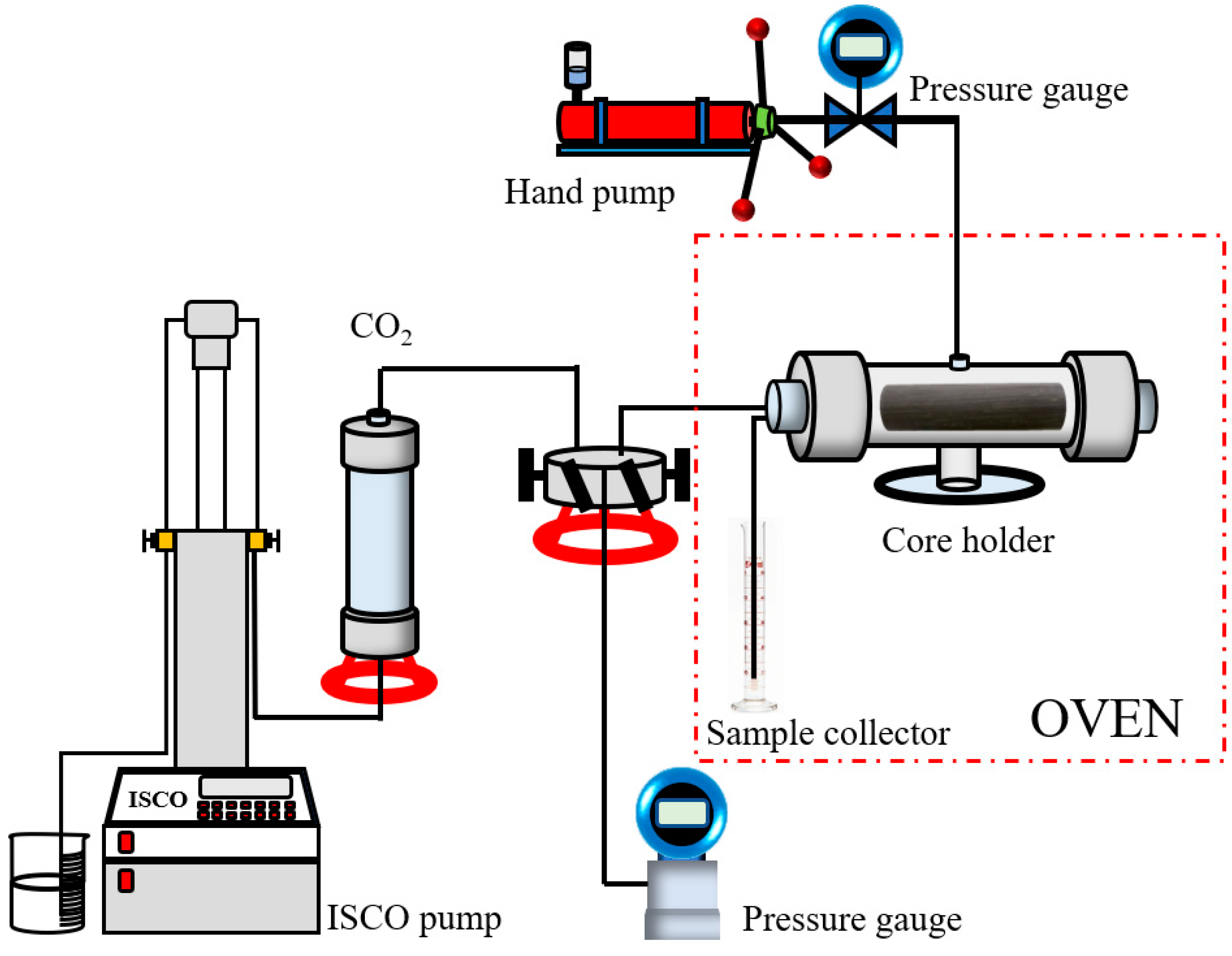
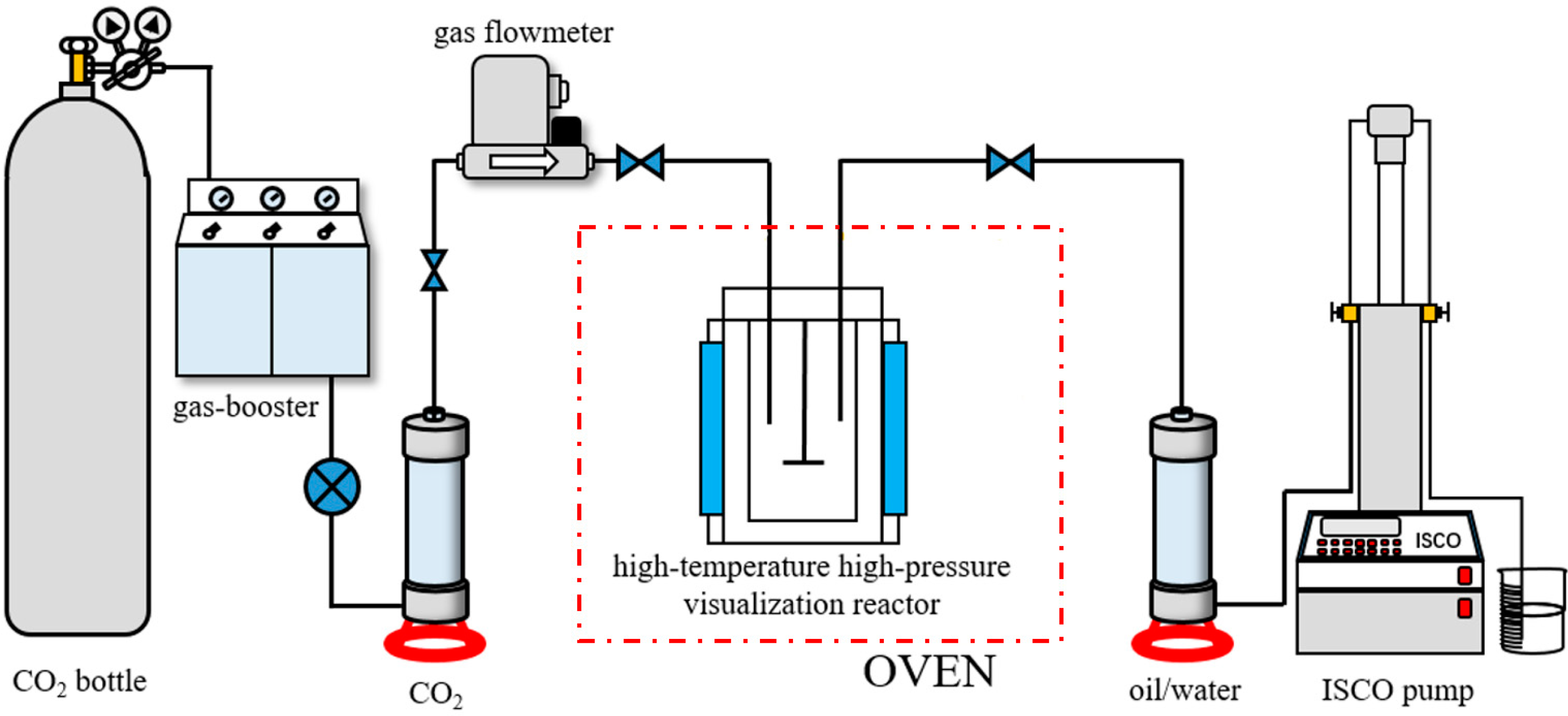
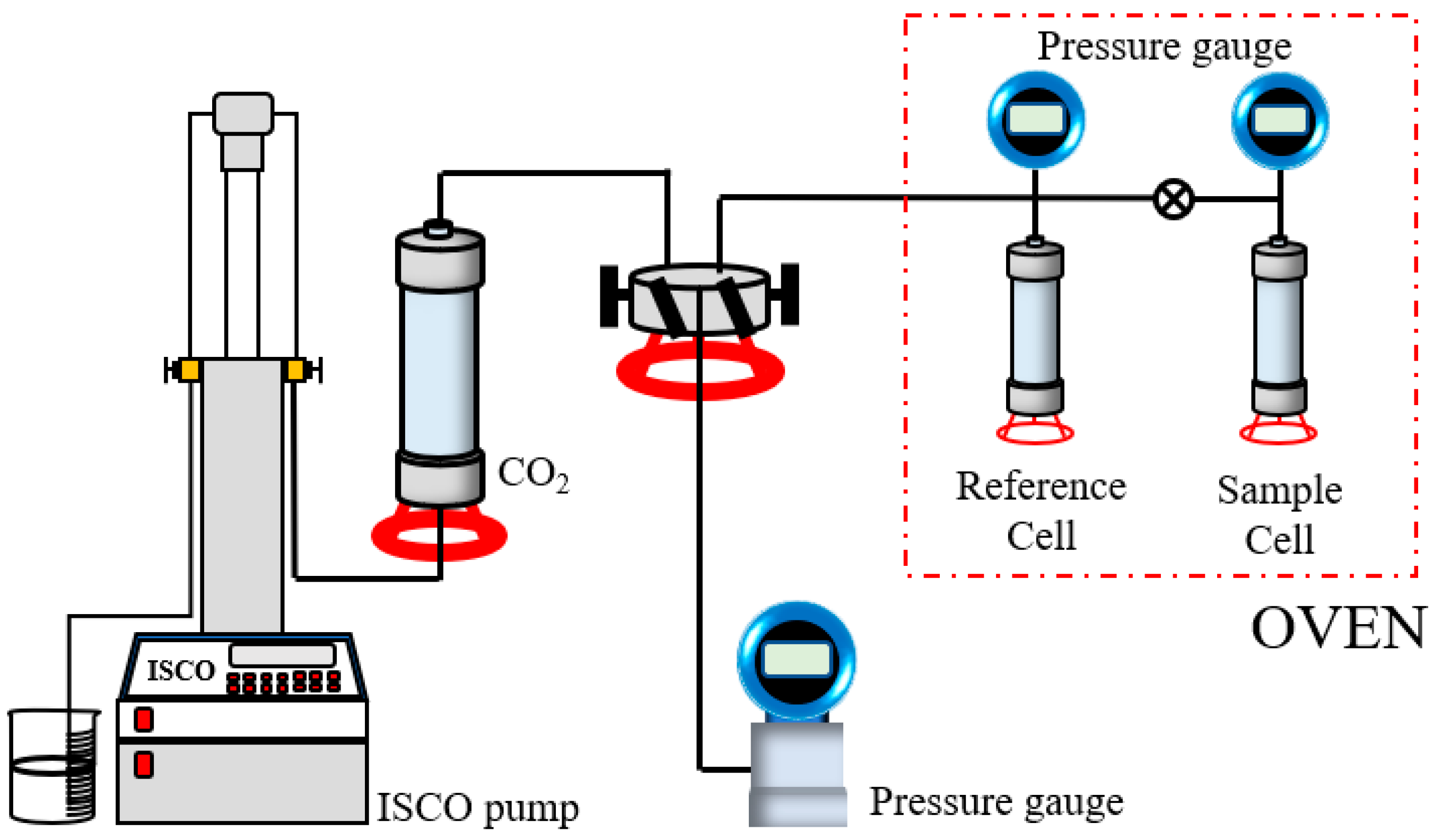
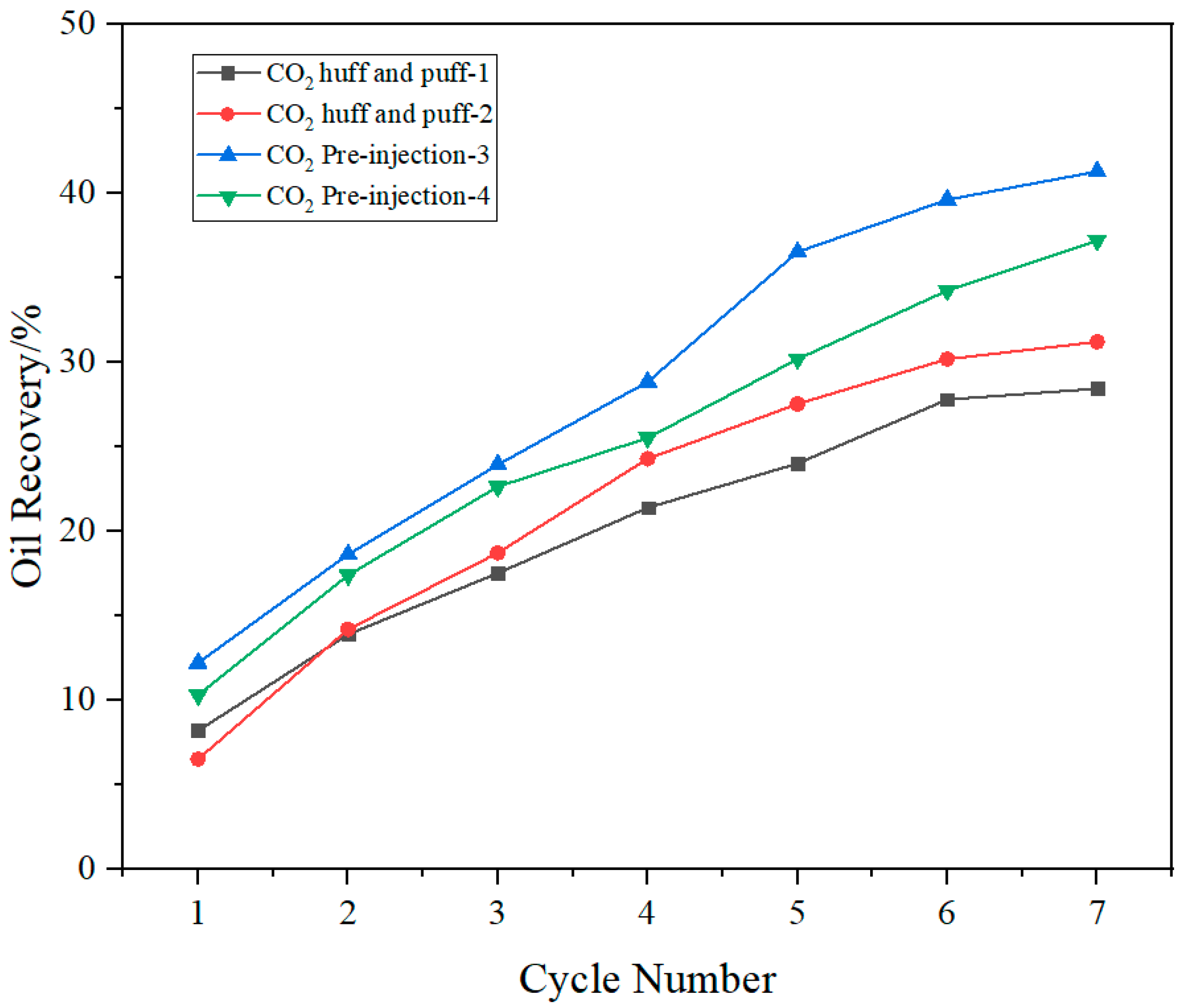
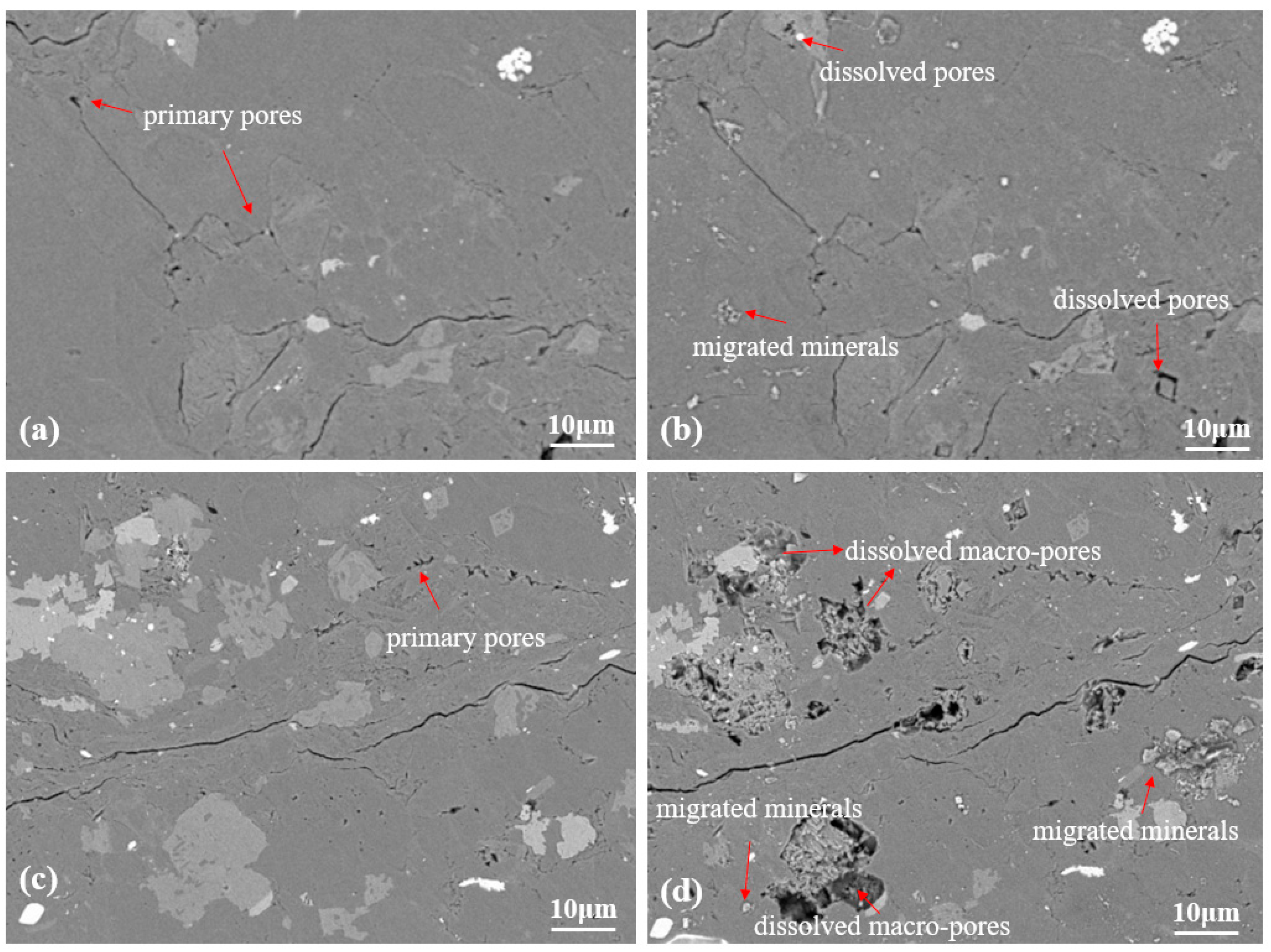
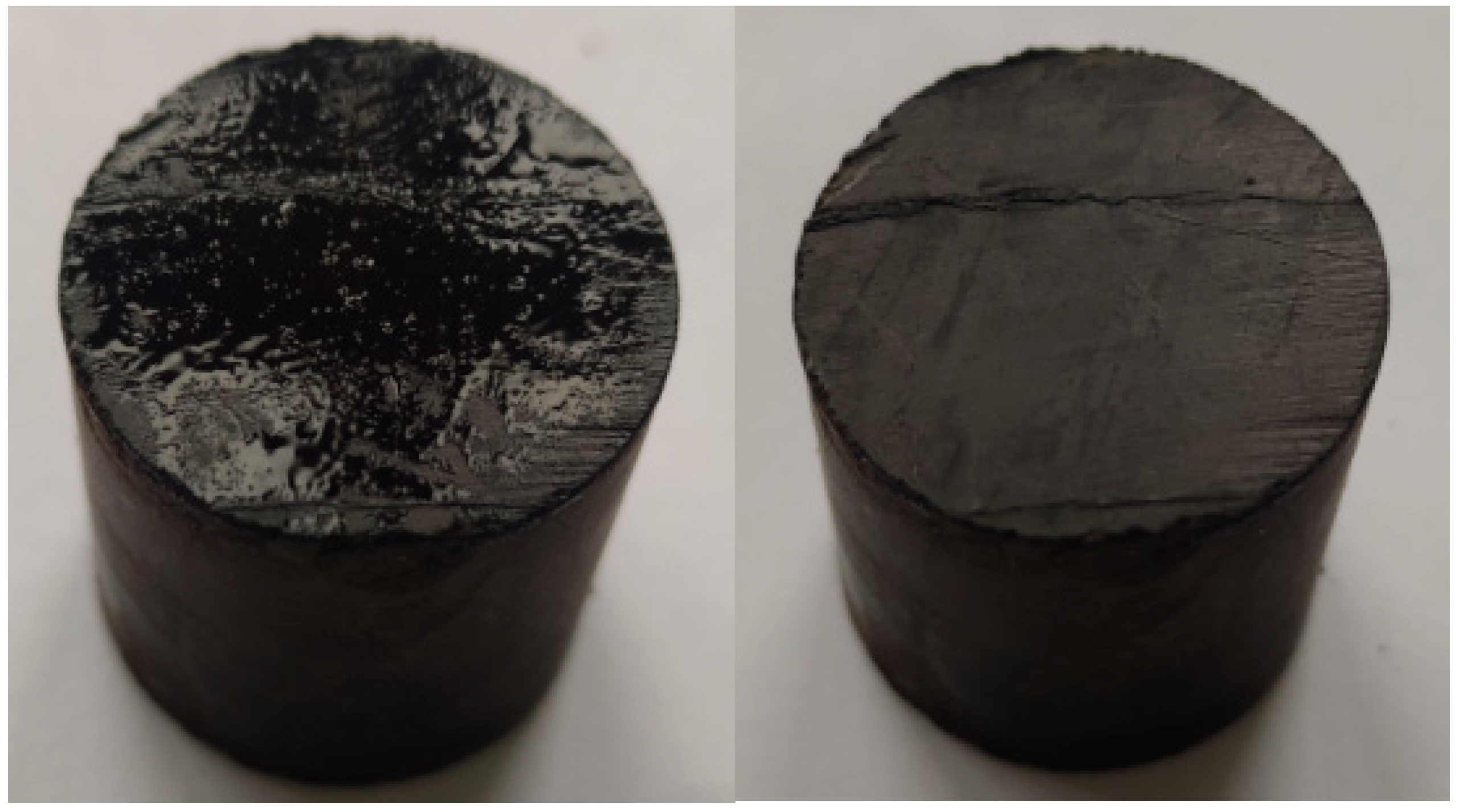
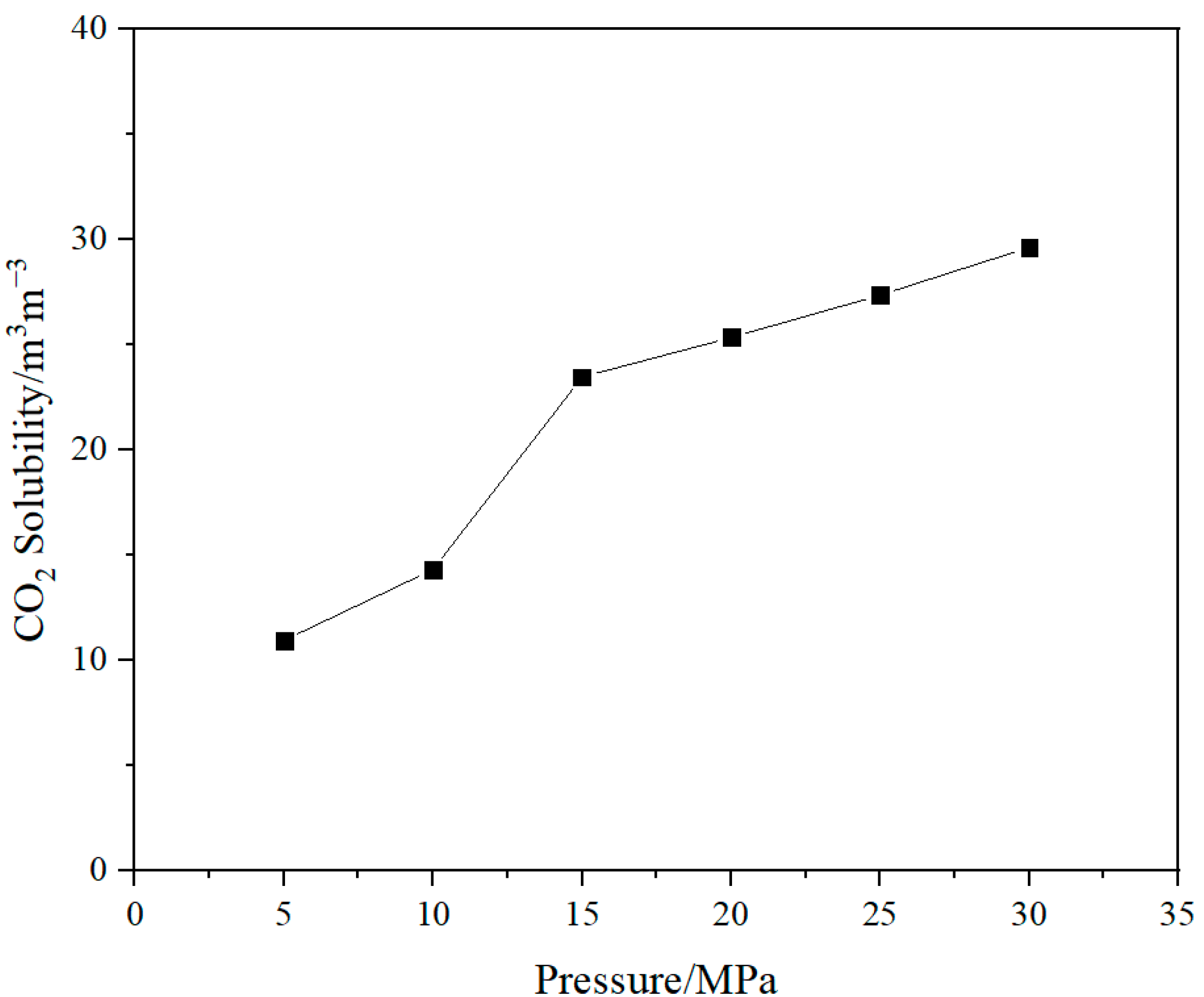

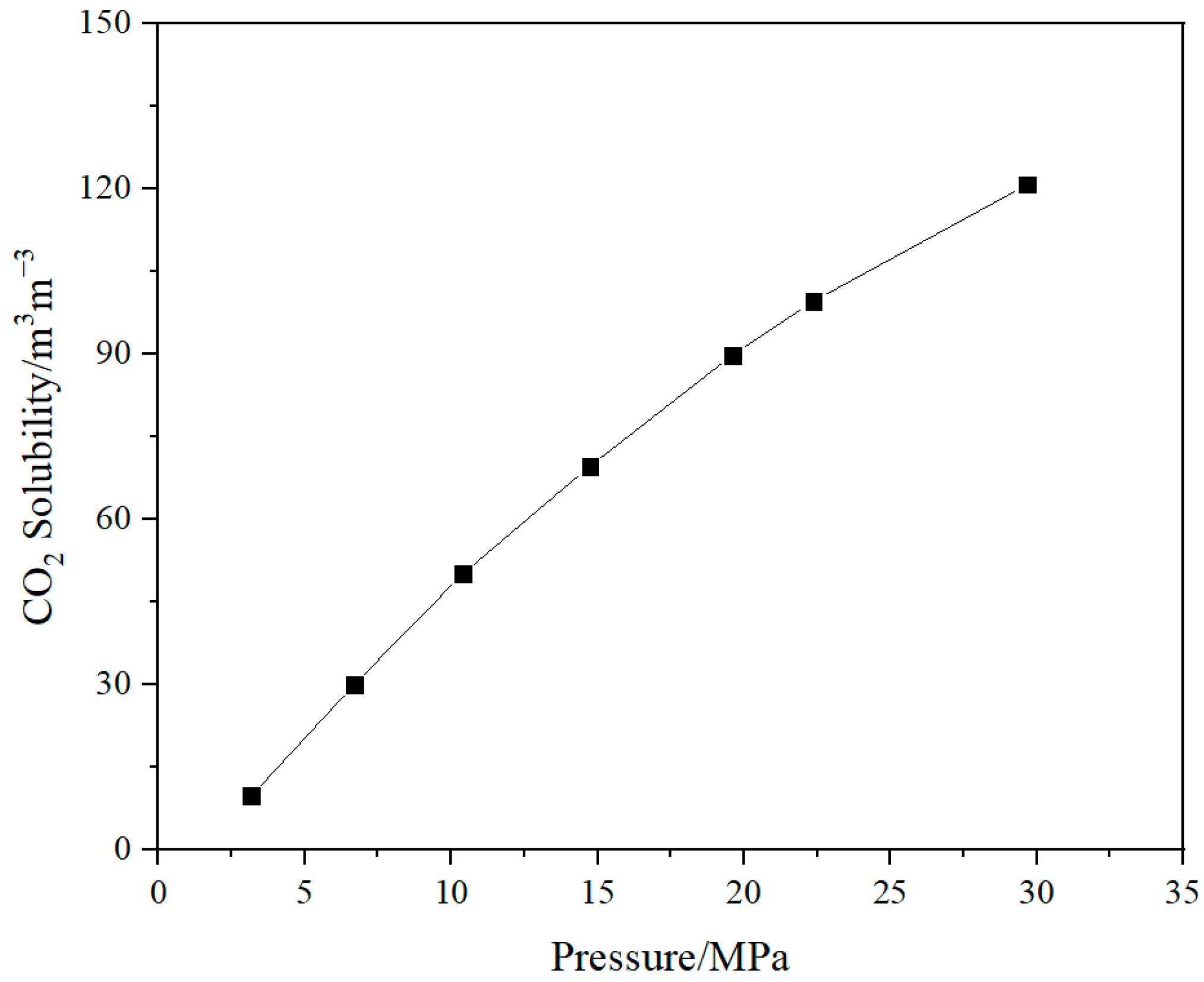
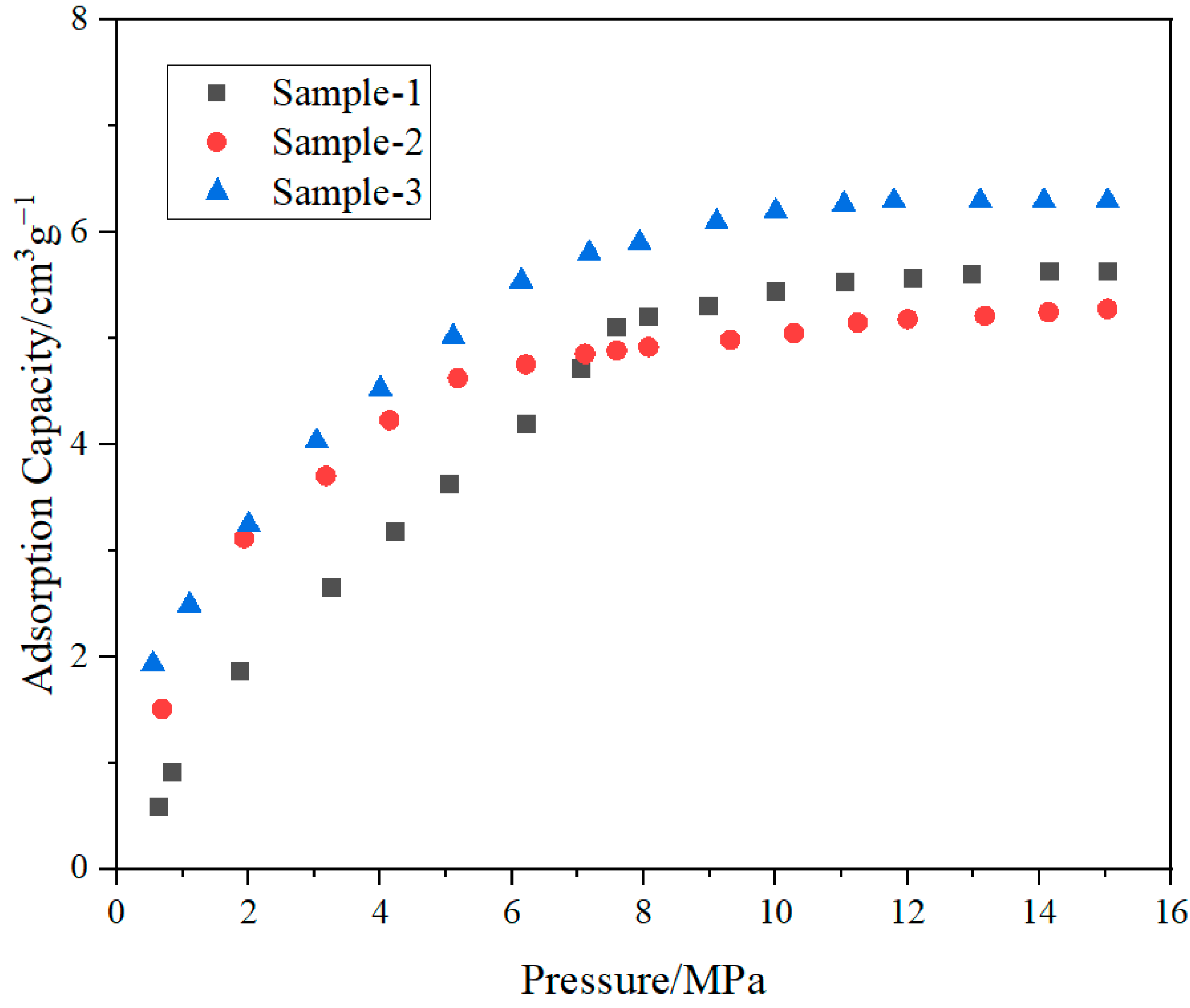
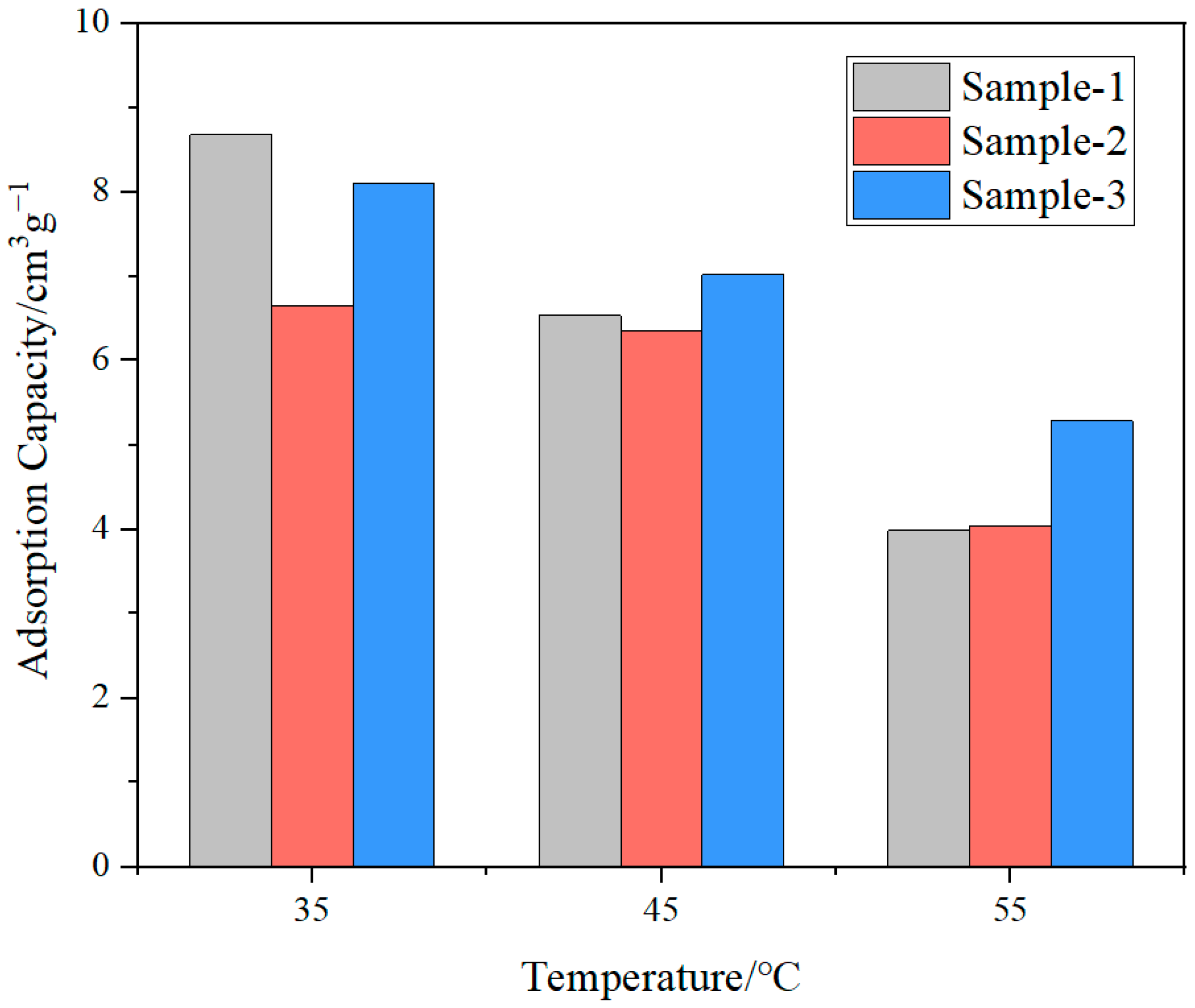
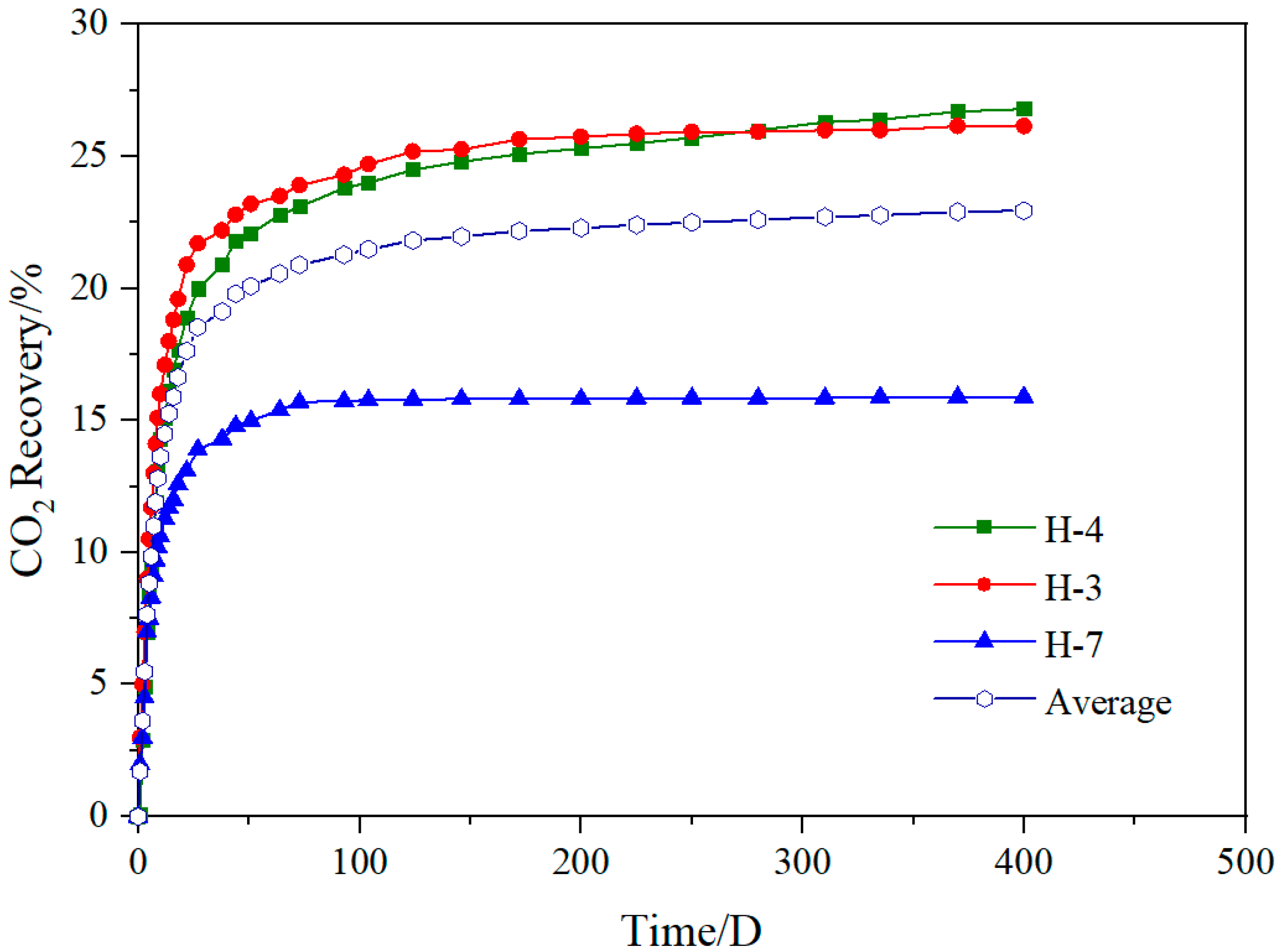
| Ions | Na+ and K+ | Ca2+ | Mg2+ | Cl− | SO42− | HCO3− |
|---|---|---|---|---|---|---|
| Concentration (mg/L) | 2320 | 39 | 5 | 1450 | 307 | 3420 |
| Specimen No. | Diameter (cm) | Length (cm) | Porosity (%) | Permeability (mD) |
|---|---|---|---|---|
| 1—Huff and puff | 2.51 | 5.01 | 5.49 | 0.0314 |
| 2—Huff and puff | 2.51 | 5.00 | 5.17 | 0.0224 |
| 3—Pre-injection | 2.50 | 5.01 | 5.81 | 0.0392 |
| 4—Pre-injection | 2.51 | 5.02 | 4.96 | 0.0271 |
Disclaimer/Publisher’s Note: The statements, opinions and data contained in all publications are solely those of the individual author(s) and contributor(s) and not of MDPI and/or the editor(s). MDPI and/or the editor(s) disclaim responsibility for any injury to people or property resulting from any ideas, methods, instructions or products referred to in the content. |
© 2023 by the authors. Licensee MDPI, Basel, Switzerland. This article is an open access article distributed under the terms and conditions of the Creative Commons Attribution (CC BY) license (https://creativecommons.org/licenses/by/4.0/).
Share and Cite
Zhang, A.; Lei, Y.; Zhang, C.; Tao, J. Enhanced Oil Recovery and CO2 Storage Performance in Continental Shale Oil Reservoirs Using CO2 Pre-Injection Fracturing. Processes 2023, 11, 2387. https://doi.org/10.3390/pr11082387
Zhang A, Lei Y, Zhang C, Tao J. Enhanced Oil Recovery and CO2 Storage Performance in Continental Shale Oil Reservoirs Using CO2 Pre-Injection Fracturing. Processes. 2023; 11(8):2387. https://doi.org/10.3390/pr11082387
Chicago/Turabian StyleZhang, An, Yalin Lei, Chenjun Zhang, and Jiaping Tao. 2023. "Enhanced Oil Recovery and CO2 Storage Performance in Continental Shale Oil Reservoirs Using CO2 Pre-Injection Fracturing" Processes 11, no. 8: 2387. https://doi.org/10.3390/pr11082387






